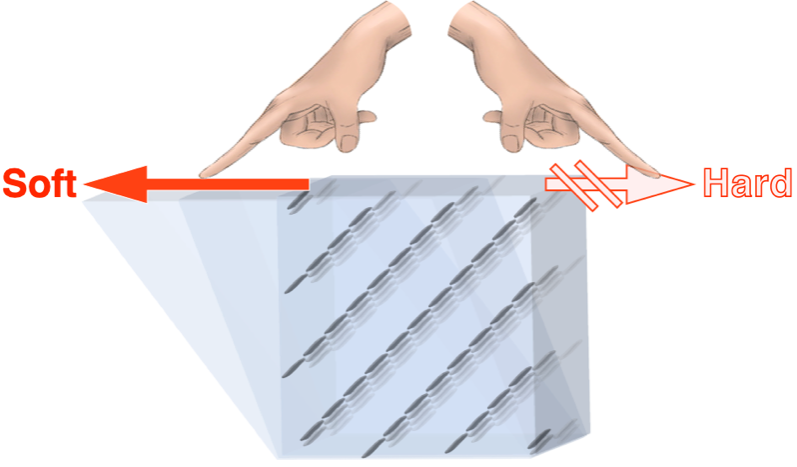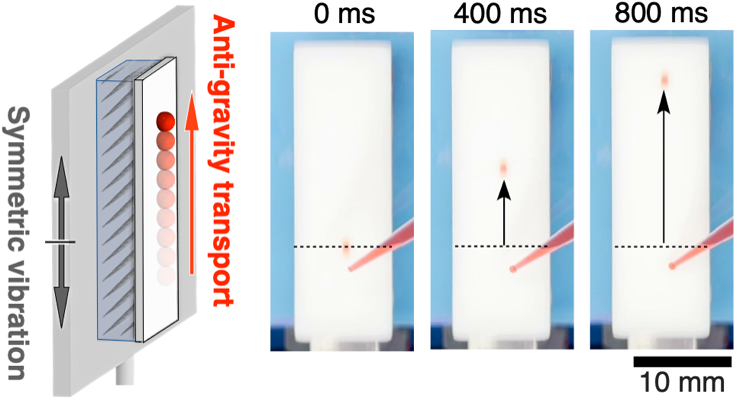May 10, 2023 Press Release Engineering
Channeling mechanical energy in a preferred direction
A research group led by scientists from the RIKEN Center for Emergent Matter Science have developed a unique material, based on nanofillers embedded in a hydrogel, that can channel mechanical energy in one direction but not the other, acting in a “nonreciprocal” way. Using the composite material--which can be constructed at various sizes--the team was able to use vibrational, up-and-down movements, to make liquid droplets rise within a material. Using the material could thus make it possible to use random vibration usefully to move matter in a preferred direction.
Channeling energy in a preferred direction is an important property that actually makes life possible. Many basic biological functions such as photosynthesis and cellular respiration are made possible by channeling random fluctuations in nature in a nonreciprocal way, to drive a system away from entropy, like the famed Maxwell’s demon. Devices that allow energy to move preferentially are used in many areas, such as electricity, where they allow AC current to be transformed into DC current, as well as in photonics, magnetism, and sound. However, it has proven more difficult to create devices that channel mechanical energy, which could also have many potential uses.
Now, a RIKEN-led group has developed a remarkable but uniform material that can is relatively easy to produce and which can perform this function. To create it, the group used a hydrogel--a soft material made mainly of water--made of a polyacrylamide network and embedded graphene oxide nanofillers into it, at an angle. The hydrogel is fixed to the floor, so that the top part can move when subjected to a shear force but not the bottom. And the fillers are set at an angle, so that they were angled clockwise from top to bottom. When a shear force is applied toward the left, from the direction the nanofillers are leaning, they tend to buckle and hence lose their resistance. But in the other direction, where they are facing away from the force, the applied shear merely makes them stretch even longer, and they maintain their strength. This allows the sheet to deform in one direction but not the other, and in fact the group measured this difference, finding that the material was approximately 60 times as resistant in one direction than the other.
As an experiment to demonstrate what this could actually do, they created a block of the material and placed it on a vibrating stand. Depending on the way it was designed and oriented material was able to channel the through the material to make droplets move to the right or left, or even upward through the network but not downward. They could also use the vibrational motion to drive a circular motion that could be controlled to be either clockwise or anticlockwise. In the case of vertical orientation, when drops of colored liquid were injected into the hydrogel, they moved upward as if by magic, with the alternating vibrational movements, which are usually not of any use, being channeled to create net motion.
Finally, as a further test, the group, in collaboration with reseachers from the RIKEN Hakubi Fellows program, place C. elegans worms on the material, and though their movements are normally random, they ended up all moving to one or another side of the hydrogel, depending on its orientation.
According to Yasuhiro Ishida of the RIKEN Center for Emergent Matter Science who led the work, “It was a remarkable and surprising result, seeing how mechanical energy could be channeled in one direction preferably, in such a clear way, and using a material that is rather easy to make and quite scalable. In the future, we plan to find applications for this material, with the hope that we can use it to make effective use of vibrational energy that, up until now, has been seen as waste.”
Rate this article
Reference
Contact
Yasuhiro Ishida, Team Leader
Emergent Bioinspired Soft Matter Research Team
RIKEN Center for Emergent Matter Science
Jens Wilkinson
RIKEN International Affairs Division
Tel: +81-(0)48-462-1225
Email: jens.wilkinson [at] riken.jp

Hydrogel for channeling mechanical energy in a preferred direction

Application of the hydrogel for anti-gravity transport of water droplets
